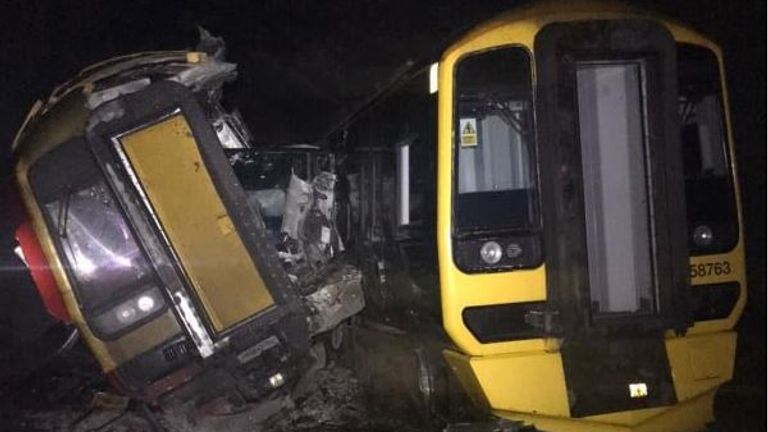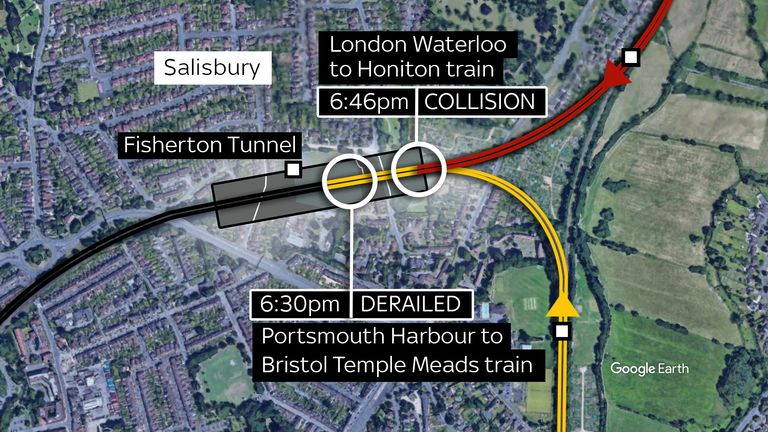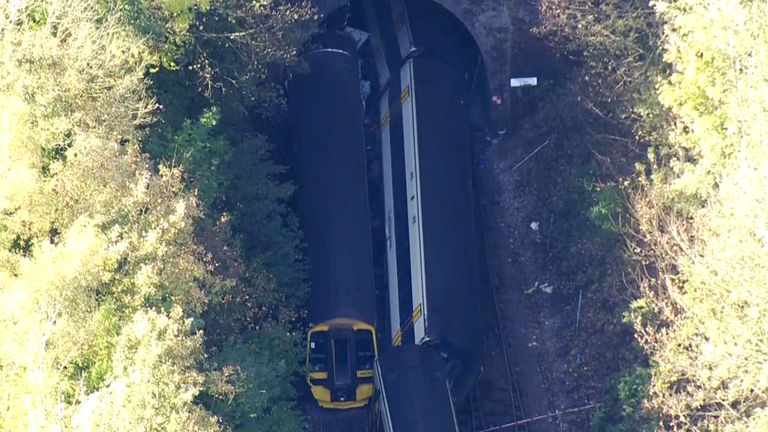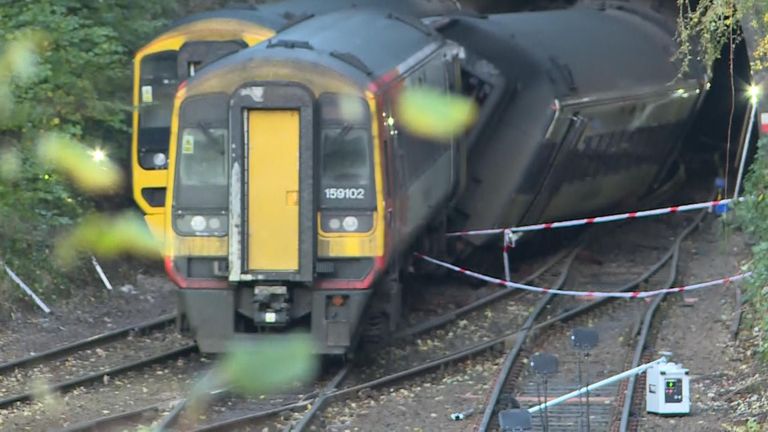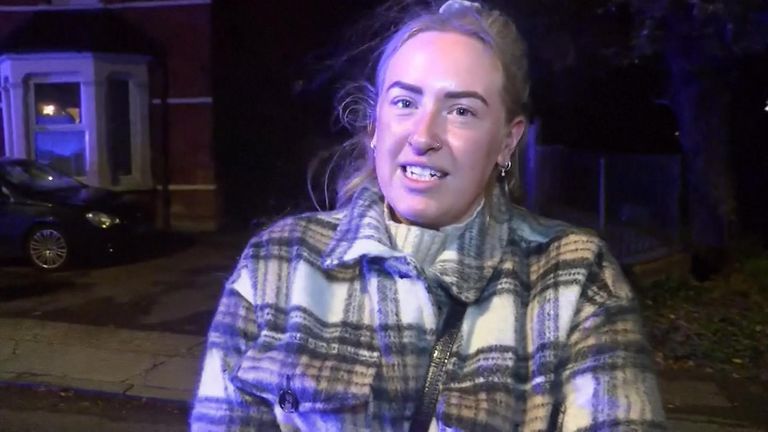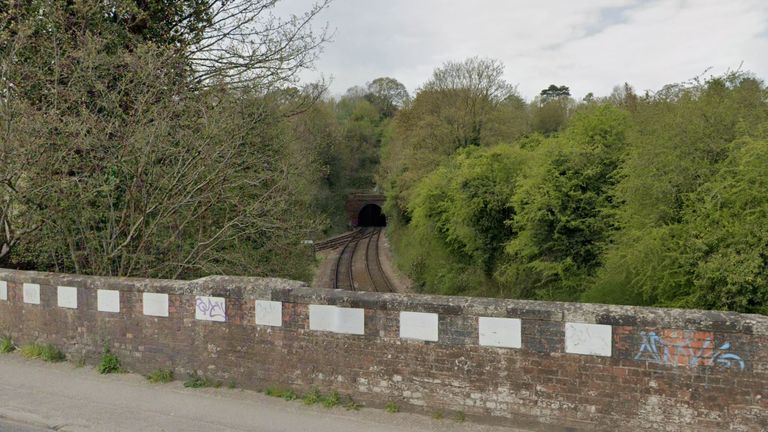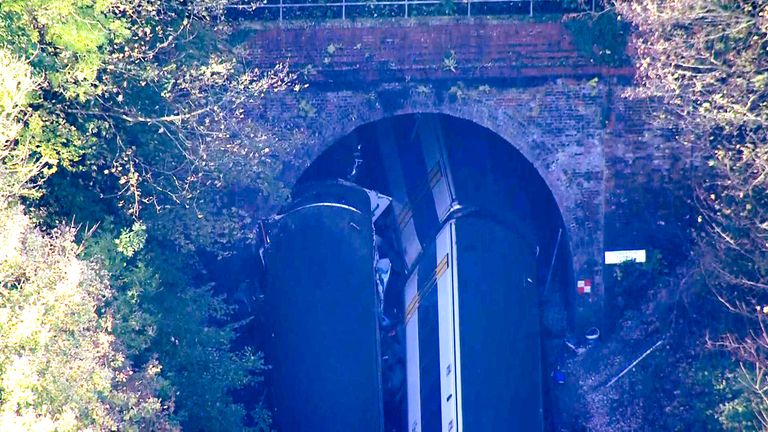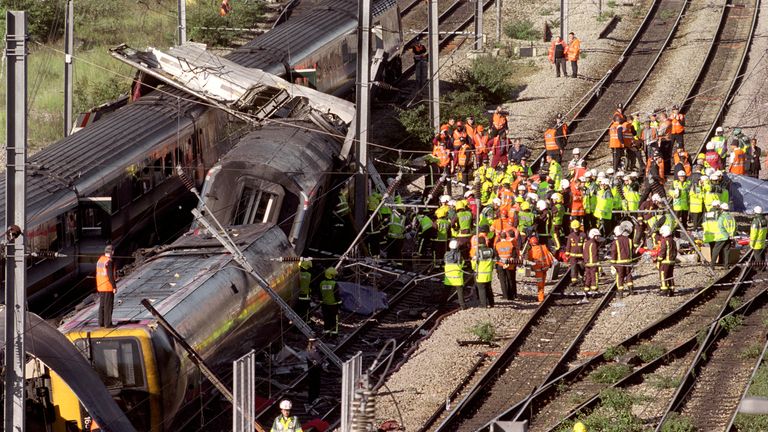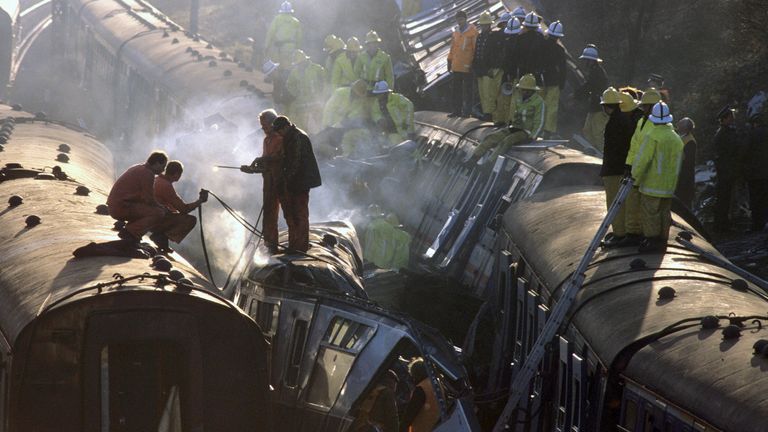A train driver has been left with “life-changing” injuries after two trains collided in Salisbury on Sunday evening.
No one was killed, but almost 100 passengers had to be rescued from the two railway vehicles and witnesses have described furniture inside the carriages coming off the walls from the impact in Wiltshire.
Several lines are still shut and a “multi-agency” investigation has been launched into how the incident happened.
Here Sky News looks at what we know so far, potential causes and similar train collisions from recent years.
What do we know so far?
At 6.30pm on Sunday 31 October, the rear carriage of a Great Western Rail (GWR) train travelling from Portsmouth Harbour to Bristol Temple Meads derailed after “striking an object” at Fisherton Tunnel near Salisbury Station, Network Rail said.
The derailment “knocked out all of the signalling in the area, and at 6.46pm, a South Western Railway (SWR) service from London Waterloo to Honiton “collided with the Bristol train”.
“Both trains were travelling in the same direction and one train struck the side of the other, causing it to derail whilst in the tunnel. The front few carriages remained upright while the back tipped on their side,” British Transport Police added.
Around 50 firefighters from Dorset and Wiltshire and Hampshire and Isle of Wight fire and rescue services were called to the scene where they evacuated the 92 passengers across both trains.
There were no fatalities, but the driver of one of the trains has suffered “life-changing injuries”.
He is in a “stable” condition and was among 13 people taken to Salisbury Hospital for treatment. All the others have now been discharged.
Those who were injured but didn’t require hospital treatment went to a temporary casualty centre set up at St Mark’s Church in Salisbury.
A ‘major incident’ was declared by the British Transport Police and an investigation launched by the Office for Road and Rail (ORR) and Rail Accidents Investigation Branch (RAIB).
What have witnesses said?
Lucy Gregory was on board the first train.
She told reporters it “felt a bit juddery” as they approached Salisbury station, before a “massive impact” saw her fall across her table, which came off the wall and left her trapped underneath.
Ms Gregory and her fellow passengers escaped via a window after rescuers smashed their way in.
Another passenger on the first train, who gave his name as Dimitri, told Sky News he “heard a big crash” and “saw flames”.
“After that the lights went out and the position of the train was like 45 degrees tilted to the right,” he added.
Dennis, another person on the first train, said he “heard a lot of girls screaming and boys shouting”.
“Then when the train stopped the lights went out,” he told Sky News.
Corinna Anderson was on the second train. She said she was “thrown against the wall” when it hit the first one.
Local resident Tamar Vellacott, 25, who lives near to the scene, said the collision created a “long rumbling sound like thunder”.
Sky’s Alex Rossi described the emergency services response as “significant”.
“At least five fire engines and as many as 10 ambulances are on the scene,” he said from the crash site on Sunday.
“Overhead, the sound of a police helicopter and a drone can be heard, as the emergency services survey the area for damage.”
Why did it happen?
The cause of the derailment and subsequent crash has not been established yet and is being investigated by the Rail Accident Investigation Branch (RAIB) – the independent government agency that looks into train crashes.
“It is too early to speculate on the cause, and our investigation will work to understand the full circumstances,” the government’s Office for Rail and Road said.
British Transport Police, who are assisting with the inquiry, said on Monday there was “nothing to suggest the train struck an object”.
But in their original statement, Network Rail said the first train did hit something before derailing.
All lines serving Salisbury – Cardiff to Bristol, Portsmouth and Brighton, Waterloo to Exeter and Salisbury to Bristol and Southampton – will be closed for investigations “until at least the end of Thursday”, National Rail Enquiries said.
‘More than one thing has gone wrong’
The only information released about the potential cause of the incident is that after the first train derailed, it “knocked out all the signalling in the area”.
Graham Braithwaite, a professor of safety and accident investigation at Cranfield University, said that usually the “fail-safe” system in place across the network means that if signalling goes out – trains are told not to pass.
“It’s an unusual accident, looking at it at face value,” he told Sky News.
“Something railways have done very well in recent years is what’s referred to as a fail-safe. It means that if you cut power off to a signal, the default is that it goes to red.”
According to Network Rail: “If there’s a power failure, the signal goes black and the driver knows not to pass a signal unless it has a green or yellow light; and if a point fails, the last signal before the set of points affected will automatically turn red so no trains pass.”
But Professor Braithwaite added that “only works if there is a signal between you and the hazard”, so the train may not have had anything to tell it to stop.
And signals also tell train drivers what speed they should be doing, he says, so if the system failed, the second train would not have been told to slow down either.
Professor Braithwaite stressed accidents of this kind are very rare.
“Rail safety performance in recent years has been brilliant and much safer than other forms of transport, like road for example,” he said.
“For something like this to have happened there will always be more than one thing that has gone wrong.
“You’re always looking for something that is unusual, because the accident in itself is unusual.”
Climate change and extreme weather a ‘real challenge to rail network’
There have been contradicting statements on whether or not there was something on the tracks.
There was nothing visible on the line in the immediate aftermath of the crash, but speaking from the scene on Sunday night, Sky News correspondent Alex Rossi said nearby trees had been “blown over by strong autumnal winds”.
Officials have not said the incident was weather-related.
But in light of further disruption over the weekend caused by flooding in Scotland, Professor Braithwaite said climate change “prevents a real challenge around extreme weather and railways”.
“Resilience of rail infrastructure is a really hot topic – whether it be things falling on the tracks, or overhead power lines being affected,” he said.
“Network Rail have cameras constantly looking at the network and checking for things nearby. They have drones, helicopters and engineers doing track patrols – but it’s a massive piece of infrastructure to manage.”
Lisa Constable, climate and weather adaptation manager for Network Rail, did not comment on the Salisbury incident.
But she said: “Ensuring the resilience of our network in the face of a changing climate is going to be one of our biggest challenges over the coming years.
“The majority of our infrastructure was designed and built in the Victorian era, and while these assets have largely stood the test of time, they were not built to cope with the increasingly changeable and turbulent weather we’re seeing today.”
Two independent groups of experts are currently looking at how to improve the situation, she added.
Have similar things happened before?
Although accidents are extremely rare, problems with trains, tracks and the rail network have resulted in a small number of fatal train crashes in recent decades.
If someone is found to have broken the law, they can be prosecuted by the police, while independent inquiries are set up to establish how the incident happened and what can be learned from it.
Grayrigg
On 23 February 2007, a Virgin train travelling at 95mph derailed near Grayrigg in Cumbia.
One person died and 88 people were injured.
Investigations revealed the train derailed due to a set of faulty points, which should have been detected during a scheduled inspection five days earlier – but did not take place.
Potter’s Bar
On 10 May 2002, a West Anglia Great Northern train from London King’s Cross to King’s Lynn passed over a set of points – moveable metal bars that allow trains to change from one track to another – at 96mph just south of Potter’s Bar station in Hertfordshire.
The points moved under the train causing part of the third coach and the fourth to derail.
The fourth carriage became detached, flipped into the air and crashed into a bridge and eventually into the station platform.
Seven people died, including one who was hit by masonry that fell off the bridge.
A 2003 report found the points were poorly maintained, causing the crash, which then resulted in a £3m fine for Network Rail and the agency being forced to bring all track maintenance in-house instead of paying contractors.
Hatfield
On 17 October 2000, a GNER train travelling from London King’s Cross to Leeds derailed at 115mph south of Hatfield station in Hertfordshire.
The eighth carriage – the restaurant coach – overturned and hit an overhead power line, causing severe damage.
Four people, who were all in the restaurant coach, died, and more than 70 were injured.
The cause of the crash was found to be “rolling contact fatigue” on the tracks.
It exposed widespread problems with privatised infrastructure company Railtrack, which was later replaced by Network Rail.
In 2005 Railtrack and contractor Balfour Beatty were found guilty of breaching health and safety laws related to maintenance.
Ladbroke Grove
The Ladbroke Grove – or Paddington – train disaster is one of the worst in modern British history.
It killed 31 people and injured 417 when two trains crashed between the two stations in west London.
On 15 October 1999, a Thames Trains service from Paddington to Bedwyn went through a red signal.
As a result, it crashed head-on with a Paddington-bound First Great Western train that had come from Cheltenham Spa.
It led to a full public inquiry, headed by Lord Cullen, which found the driver of the Thames Trains service had “more likely than not” failed to distinguish the red signal, mistaking it as safe.
He died in the crash, but had only been qualified for two weeks.
Southall
The Cullen Inquiry was also launched in response to a crash just a few miles away two years earlier on 19 September 1997.
It killed seven people and injured 139 when a Great Western Rail train from Swansea to Paddington failed to slow down for two warning signals and had to use the emergency brake when it saw a red one.
Although the driver used the brake, it was too late, and the passenger service hit a freight train at 80mph.
It was later discovered the automatic warning system in the GWR train wasn’t working and the fault had not been reported.
The driver was charged with manslaughter by gross negligence, after he was found to have been packing his bag when the red signal appeared, but the case collapsed.
Clapham Junction
The Clapham Junction train crash on 12 December 1988 is the worst in the UK in the past 35 years.
It happened just south of the London station, when faults with wiring and the signalling system saw a morning rush hour train from Poole crash into one from Basingstoke that had stopped before Clapham.
The impact saw the Poole service sideswipe an empty oncoming train – killing 35 people and injuring 484.
A report chaired by Anthony Hidden QC found faulty wiring had caused an incorrect signal.
British Rail, which ran the network before privatisation in the late 1990s, was fined £250,000 for violating health and safety laws.
